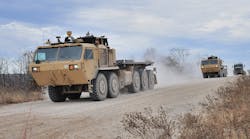Fatigue is often a major factor for drivers in convoys of military vehicles that must cover long distances. The solution lies in using an efficient man-machine interface and allowing the machine to do the driving. That solution, as developed by Lockheed Martin, is the Autonomous Mobility Applique System (AMAS), which successfully logged more than 55,000 testing miles during the U.S. Army Extended Warfighter Experiment (EWE) at Fort Leonard Wood, Mo. and Fort Bliss, Tex.
“The testing was conducted by soldiers and Lockheed Martin personnel over several months at two major military installations in a variety of mission scenarios,” said Kathryn Hasse, Combat Maneuver Systems director at Lockheed Martin Missiles and Fire Control. “Soldiers operating the AMAS vehicles provided us very positive feedback about how the system freed them up to do the job of a soldier instead of the job of a truck driver.”
AMAS is a low-cost, low-risk autonomy kit for military vehicles that provides driver warning and assistance with leader-follower capabilities and a path to full autonomy. The Convoy Active Safety Technology (CAST) that is used in the AMAS autonomously controls convoy vehicles to significantly reduce crew fatigue, eliminate rear-end collisions, enhance operator situational awareness, and enable a more effective response to attack.
The technology features a simple user interface with the capability to sustain steady 50 mph speed and maintain autonomous control for a distance of more than 100 miles. It includes obstacle detection and avoidance and allows moving convoys to split up and rejoin as needed, under autonomous control. CAST is capable of lighted night operations as well as black-out night operations, to avoid detection.
When integrated into combat ground wheeled vehicles, AMAS provides driver warning/driver assist and semi-autonomous leader/follower capability, significantly increasing safe convoy operations for military vehicles. The system reduces manpower needs for convoy operations, reducing fatigue and helping soldiers to maintain alertness against enemy activity.
The EWE was sponsored by the U.S. Army Training and Doctrine Command (TRADOC) and managed by the U.S. Army Tank Automotive Research Development and Engineering Center (TARDEC). Testing of the AMAS system during the EWE included using palletized loading system vehicle convoys in which the lead vehicle was driven by a Soldier and the following vehicles (three to four) followed robotically. “AMAS continues to prove itself as a valuable asset for our military by safely operating in complex environments,” Hasse noted. “We believe that AMAS is ready to move forward toward the ultimate goal of widespread fielding across multiple military applications.”

